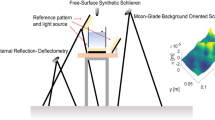Abstract
Current techniques of water wave visualization such as shadowgraphy and stereo photography are widely used but are deficient in many aspects. Refraction based visualization observes the bending of light as it traverses across a liquid-air interface. This work describes the continued development of techniques to measure the surface height of a liquid free surface. The method, Reference Image Topography, utilizes refraction of light at the free surface as a function of the local angle of that surface. Particle Image Velocimetry (PIV) software is used to evaluate apparent dislocations of the target image viewed through the free surface, which are approximately proportional to the surface angle. High-resolution images are presented of the dynamic surface topography for a point source and the shallow water flow around a vertical cylinder.
Similar content being viewed by others
References
Adrian, R. J., Particle-imaging techniques for experimental fluid mechanics, Ann. Rev. Fluid Mech., 23 (1991), 261.
Brocher, E. and Makhsud, A., New look at the screech tone mechanism of underexpanded jets, Eur. J. Mech. B/Fluids, 16 (1997), 877.
Fomim, N., Lavinskaja, E., Merzkirch, W. and Vitkin, D., Speckle photography applied to statistical analysis of turbulence, Optics & Laser Tech., 31 (1999), 13.
Fu, H. and Rockwell, D., Shallow flow past a cylinder: Control of near wake, JFM, 539 (2005), 1.
Hughes, H. A., Grant, H. L. and Chappell, R. W., A fast response surface-wave slope meter and measured wind-wave moments, Deep-Sea Research, 24 (1977), 1211.
Jahne, B., Klinke, J. and Waas, S., Imaging of short ocean wind waves: a critical theoretical review, J. Opt. Soc. Am. A, 11 (1994), 2197.
Tanaka, G., Okamoto, K. and Madarame, H., Experimental investigation on the interaction between a polymer solution jet and a free surface, Exp. Fluids, 29 (2000), 178.
Zhang, X., Dabiri, D. and Gharib, M., A novel technique for free surface elevation mapping, Phys. Fluids, 6, S11 (1994).
Author information
Authors and Affiliations
Additional information
Andreas Fouras: He received his M.Eng.Sci. in Mechanical Engineering in 1998 from Monash University. He has worked at Monash University since then in the areas of Quantitative Imaging, Quantitative Flow Visualization and Bluff Body Turbulence. His particular area of interest is PIV technique and software development.
Kerry Hourigan: He is Professor of Mechanical Engineering, Director of the Biomedical Engineering Technology Alliance (MuBeta) and a Director of the Fluids Laboratory for Aeronautical and Industrial Research (FLAIR) at Monash University. Professor Hourigan obtained his Ph.D. in astronomy from Monash University in 1981 and was a NASA/NRC Research Associate at Caltech Jet Propulsion Laboratory (1982–83), a Senior Principal Research Scientist at the CSIRO (1984–95), and a visiting professor at Caltech GALCIT, Saitama University, Universite d’Aix-Marseille and IMF, Toulouse. His research interests include: aerodynamics, biomedical and biofluids engineering, optical diagnostics, CFD, and bluff body wakes and vortex induced vibration.
Masaaki Kawahashi: He received his MSc (Eng) degree in mechanical engineering in 1968 from University of Electro-Communication (UEC), and his PhD (Eng) from The University of Tokyo in 1978. After graduating from UEC, he joined at Saitama University as a Research Associate. His current position is a Professor of Fluid Dynamics in Department of Mechanical Engineering, Saitama University. His research subjects are finite amplitude wave motion, development of acoustic compressor, PIV applications to centrifugal fan, and analysis of oscillatory air-flow in bronchial model by using micro-PIV.
Hiroyuki Hirahara: He received his Master of Mechanical Engineering degree in 1983, and his Doctor of Engineering degree in 1986 in Kyushu University. After the DE course, he worked in atomic power plant engineering section in Toshiba Co.Ltd. He worked as a Research Assistant and Lecturer of Saitama University, before taking up his current position. He is an Associate Professor of Saitama University, and his research subjects are high speed flow, supersonic flow with condensation and evaporation, flow measurement techniques, optical measurement techniques, development of micro wind turbines and creature’s flow simulation.
Rights and permissions
About this article
Cite this article
Fouras, A., Hourigan, K., Kawahashi, M. et al. An improved, free surface, topographic technique. J Vis 9, 49–56 (2006). https://doi.org/10.1007/BF03181568
Received:
Issue Date:
DOI: https://doi.org/10.1007/BF03181568




